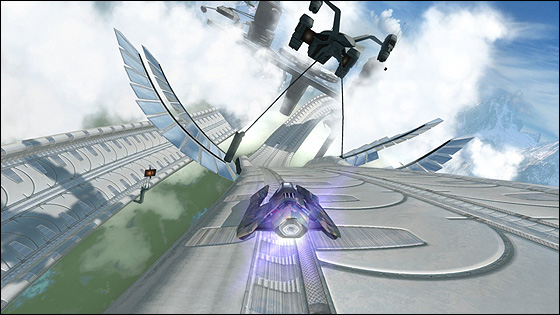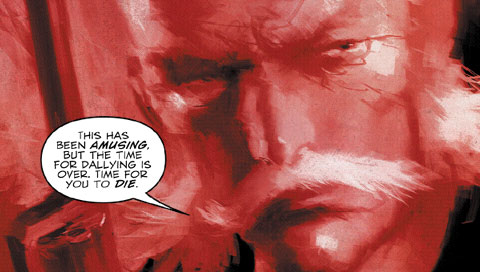The Cultural Implications of Dialects in Video Games
May 20th, 2009
The next entry in my GameSetWatch column was posted a few days ago, you can find the link here;
Column: ‘Lingua Franca’ – Implications Of Dialect In Dragon Quest IV
This time around I look at the use of dialects in video games and discuss the cultural implications that dialects can have on play, as well as suggesting ways to weave this to an advantage. Initially I wasted many words finding my voice for the article, but eventually what I wanted to say came out. I’m weary of a few of the comments I made in the article, one or two which may in fact be generalizations, still the weight of the article is strong. It’s been interesting to observe the feedback from people who have a different interpretation of English dialects to my Australian flavoured opinion.
I’m really starting to find some weight behind this column, as I’m practically plundering the depths of unexplored terrain. It’s similar to a project I’m currently working on now regarding Chinese-Chinese and Chinese-foreigner communication – both fields represent a lack of proper study.
Lastly, I’ve completed the extended introduction of my next column which is a critique of Portal in regards to Erving Goffman’s work on social interaction and institutions. This is a topic that I’ve had on the tip of my pen for almost a year now, I suspect that this will probably be one of my best pieces of writing, it’s shaping up that way already.
You may hear more opinions on Dragon Quest IV in another guest article shortly.
Tuition of Curves: WipEout HD
May 18th, 2009

Mastery of WipEout demands the player become acquainted with the game’s beautiful formation of archs, curls and bends. Track design that accentuates curvature, curvature that’s as pleasant as the well rounded assets of a shapely women; WipEout‘s design converges at elegance.
Track design is the strongest embodiment of WipEout‘s womanly feel. It narrows and widens with the inhaling and exhaling of the game’s cleanly chaotic atmosphere. Security railings are removed, opening up space before large descents into hard crooks that loosen after the transition. Bends tighten following moments where there is visible air between the pod-like crafts, breathing in and hardening the friction between vehicles. The in and outwardly shifting design is a catalyst for the vicious confrontations that only escalate on higher speed classes. Tracks are a construction of sequentially well timed hoop jumping obstacles that train you to breathe in time with the momentum of each track, handling each curve with precision. WipEout heightens the affinity between player and race by employing an firm gravity between craft and track that bobbles with the waves of ascents and descents in the track. When I shared lunch with Daniel Purvis from Graffiti Gamer he described this game as though being strapped to the front of a rocket. It’s the gravity to the track then that makes you feel pinned down to earth, held close to the track and its design. Your craft is raised but at the same time bolted down, hovering just above the ground, ensuring that turning never feels slippery as you direct the craft like a canoe, using the back to steer the nose of the vehicle. The bind, holds you tightly to the track and never allows you to skip any part of the training course of opportunities to tackle a rounded corner. It’s as though the whole game is centred around tackling these womanly curves. The difficulty too enforces this by demanding a mastery set by the game’s tough series of grids. And with each of the four speed classes, the way you manage each curve changes based on the point on the difficulty continuum. This itself is the whole game; maneuvering curves in a series of training drills and then doing it again with modest reassessment on higher speeds.

Graphic design is similarly slick. Special note must go out to the cute, shifty animations for each of the fictional in-game brands. The visual design of the brand iconography has clear inspirations from Asia with splashes of Japanese and companies for products of particular urban Asian reference including robots, noodle bars and energy drinks. The menu design is similarly serene and tidy. In game the same holds true; tidy, clean, futuristic. The colour selection and hues play again into the consistently feminine feel of the game, with light blues, greys and pinks overlayed with a slight grey tinge to create a plushy, “club” vibe. This is particularly true in the later tracks Ubermall and Sol2. WipEout loses the realistic shell in Zone mode, where the game pulsates with fruity colour and rich hues. It presents some of the most visually striking imagery I’ve ever seen, and springs to life with visualization of the background music.
The 9 track selection of favourite clubbing tunes should be familiar, even to those not immersed in the music and culture. I certainly recognised a good deal of them, surprisingly. It might have been Cam Shea who said that the WipEout series is essentially ‘Clubbing: The Game’ and like Purvis’ statement I think it’s quite true. The music is lifted straight from the scene, but so too is the atmosphere as I’ve outlined. The whole feminine side of WipEout shares much similarity with clubbing culture and can easily be pointed to as part of the source material of this series.
The game design accentuates womanly curves, the visuals textualize this metaphor with light colours, elegant architectural design, soft glows and an airy atmosphere, and lastly the sounds are a palette of the best from a woman populated culture. These design decisions not only create a womanly aesthetic, but also a womanly feel. The package is balanced in a way that feels poignantly feminine yet isn’t explicitly over gendered.
Microtransactions: Pirating the Novel and Memberships and Twitter
May 16th, 2009

Pirating the Novel
There’s a .txt file that resides in a folder on my desktop ironically labelled ‘Desktop’. This text file has a list of three things; my backlog of games to buy, current-gen games I need to buy when they hit the cheap and an exhaustive list of second-tier titles that I’d like to invest in, if time allows. I sometimes swoon over this list, as well as that sheet of ‘Games to Complete’ that I sometimes refer to; the one above my monitor. Sometimes it’s better to envision yourself enjoying these games/write about them rather than actually go to the labour of playing them. Hmmm…
Anyways, I was running through my list and came across an aggravating tick of a game. I love the thrill of collection and bargaining, infact I have a couple of eBay titles qued up right now awaiting the snipe, but some games no matter where you find them refuse to budge from their steep price tags. One of those is Metal Gear Solid Digital Graphic Novel for the PSP. Ever since I first spotted this in store – and by golly, what a surprise! – it’s remained fixed at $AUD50+. It’s $20/30 (not sure what the going rate on PSP games is nowadays, always cheaper than DS though) shy of a full price title, yet in reality, this is a mostly non-interactive experience, similar to those interactive DVD games, so why the premium? Furthermore this title was blessed with an ultra limited released and overall lack of publicity – you had heard of this game before right? So Digital Graphic Novel puts me in a tight spot, difficult to find and when you do it’s top dollar.
So then I decided to go to YouTube to see if I could find some video and save myself the $50, and sure enough I found a 16-part playlist (woah – almost 3hrs!) that now resides in .mp4 on my desktop, next to the ‘Desktop’ folder.

I’m morally split on the decision though, I mean, if I choose to watch these videos, will it be a form of piracy? A devious, devious sin that I avoid as much as possible. Truth is, I will watch the videos, but more concern lies in the classification of this activity. These videos are on a free to view website and openly available. If one classes MGS DGN as a game then therefore watching the video is the same as watching a play through and there’s nothing wrong with that at all. Games are interactive media and there is a layer of interactivity involved which I’d be missing out on, so no worries, right? Then again, I don’t think there will be any glimpses of gameplay in the video (ie. the player will just watch), so in that case we’re effectively watching a long cutscene which makes up the bulk of the game. Now if this is the case then what percentage of Metal Gear Solid 4 (ie. the cutscenes) is available online? Well there’s no doubt a montage of that stuff too, so probably a good chunk, therefore what exactly does this all mean? And what’s fair game?
One could also make the same claim for Linger in Shadows, the PS3 interactive short.
Memberships and Twitter
I recently ranted on about pissant membership groups within the blogging community in a post that I dare not upload in fear that you’ll hate me more than my Australian spelling of colour. Embedded within the article were some rather fantastic (if I do say so myself) musings on Twitter’s role in all this kerfuffle. Take a read;
“Twitter, is the fertile soil to plant, grow, share and trade cultural norms – the medium in which is used to emit and transfer. In fact Twitter is more than just the medium, it’s the ideal medium. The social networking element keeps tweeters in touch on a minute-by-minute basis while not binding them to any real time conversation. The tight word count moderates each sentence making it low fluff and straight to the love. The response system flaunts replies to people within the same network. This whole setup is ideal for users to flirt and trade ambiguous nudge, nudge, wink, wink commentaries among each other, and then transmit their dialogue to onlookers. It’s a contained system, built around the utterance; a distilled cultural transmitter. As said to death in the cultural studies field, language = culture. Therefore Twitter’s composition is a fantastic, quantifiable way to observe memberships groups validating their cultural identity between one another. It’s in Twitter that I draw much of my reasoning as it’s a transparent model to view this culture.
When I cruise through other people’s Twitter pages and observe the small talk, I’m often baffled at what’s actually going on. People declaring their membership roles or attempting to grow their seed, by throwing strings of replies to others. It’s a society alright. A society where people are constantly stating their roles and relationships. To “fit in” people have to acknowledge the presence of a membership group, whether they’re in it or not. And with only 140 characters to play with, you need to be discrete about this, which is where the love letters, and ultimately masturbation comes into play. In Twitter, if you want to be part of the elusive membership group you have to wank it all up on an open stage, and therein lies my frustration, as the audience member of that stage.”
Wow, witty and a valid contribution to the language, tech and culture fields. How do I do it? 😛



 Game Design Companion: A Critical Analysis of Wario Land 4 - $7.99
Game Design Companion: A Critical Analysis of Wario Land 4 - $7.99 Level Design: Processes and Experiences
Level Design: Processes and Experiences Speed Boost: The Hidden Secrets Behind Arcade Racing Design - $5.99
Speed Boost: The Hidden Secrets Behind Arcade Racing Design - $5.99 Adventures in Games Analysis: Volume I - $5.99
Adventures in Games Analysis: Volume I - $5.99







